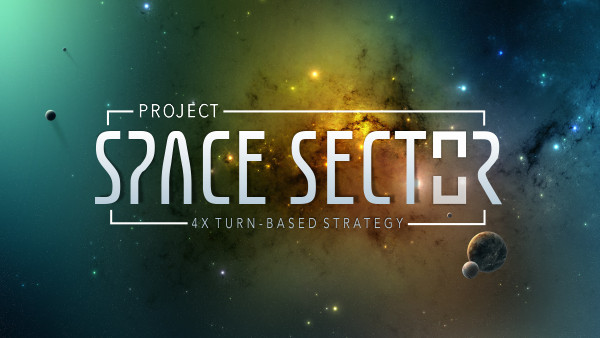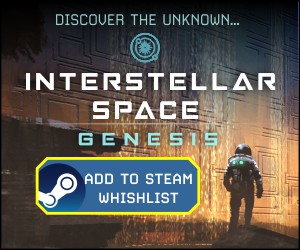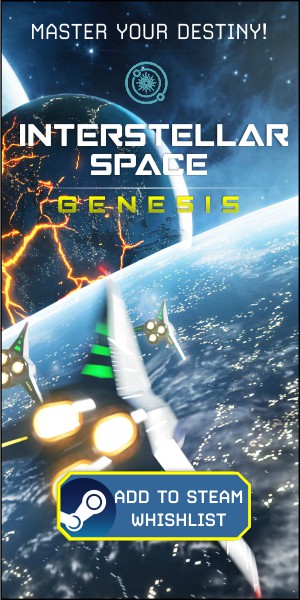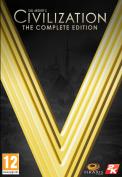
Hi everyone!
Today we kick off a series of dev diaries for Project Space Sector, which we intend to be releasing in a 2-week or monthly fashion. In case you missed the announcement, Space Sector is developing a turn-based space 4X strategy game, which will be a spiritual successor to Master of Orion 2.
We start with the game’s starmap and exploration mechanics.
Motivation and Rationale
We believe that exploration is probably one of the best parts of a 4X game, and at the heart of what makes these games extremely fun to play, especially at the beginning.
And this is the issue: it’s usually good… “at the beginning”. The exploration experience, the curiosity feeling and the surprises that go along with it, usually end too soon. The exploration needed more meat and to stay relevant, and interesting, throughout the game’s later stages.
We also believe that Master of Orion 2 offered a great basis for what a starmap should be like in a game like this. One that is easy to understand, navigate, and that, ideally, can fit in the screen without the need to be doing constant zooming-in and out to get to places.
Ultimately, it’s all about offering the player the feeling that the starmap, the world state, is easy to grasp, totally under the player’s control and that many surprises, and wonderful feelings of discovery, await.
Realism meets interesting and approachable gameplay was also at the heart of what we wanted to offer with respect to the starmap and exploration. So, a lot of what is currently known, and unknown (but speculated) by science was used to the extent that we think was appropriate for the game’s scope and that would help with immersion and fun.
With this in mind, let’s present what we’ve come up with.
The Galaxy
The universe is full of wonder, with lots of exotic places to explore and exploit.
We believe that everything we needed to make exploration more fun is already out there, mysteries to be resolved in so many different celestial objects already known to science that offer plenty of fertile ground for us to use in the game.
So, on top of Master of Orion 2 star systems, which could have planets or not, and other objects, we have the following types of systems and celestial objects, most of which will not be visible when the game starts:
- Main sequence star: the classic star system with planets, asteroid belts and gas giants. These are all visible at game start (of course, they need to be explored for the details to be revealed). There are blue, white, yellow, orange and red main sequence stars, each with their own advantages and disadvantages in terms of possible events, planet number, planet richness, the amount of asteroid belts and gas giants present as for other factors like ancient ruins presence likelihood, tidal lock probability, ecologic maturity, certain types of planet specials presence, among others.
- Brown dwarf: due to the unusual properties of the these failed stars, planets orbiting them tend to have more specials and of a specific more unique kind. Sector basic scan may reveal brown dwarf systems; only sure to reveal at “advanced scanning” level (more details on exploration/scan levels will be presented in the “Types of exploration” section below).
- White dwarf: planets orbiting these dead stars will have seen their cores stripped, those which have survived the red giant phase of their star, that is. These will tend to be very old systems, which makes them likely places to find ancient ruins and certain types of planet specials. White dwarfs may be revealed at basic scan level; only sure to reveal at advanced level.
- Rogue planet: these are planets that don’t orbit any known star but orbit the galaxy directly. They can be of any type, tend to have a special due to the planet’s uniqueness and are only revealed at full scan. Think hidden bases for late game
 :)
:) - Black hole: these are stellar remnants of stars that went supernova and had more mass than our Sun. They don’t have planets orbiting them but they may have asteroid belts for mining exploitation. Black holes can be further exploited for production (usually more than in other stellar remnants), research and tourism bonuses. They are also the source of antimatter, one of the game’s strategic resources, which will be important for the mid/late game (strategic resources will be detailed in the research dev diary). Black holes are revealed at advanced scan (low chance at basic).
- Neutron star: a neutron star is also a stellar remnant, which star was bigger than our sun when it exploded in a supernova but smaller than the mass required for it to become a black hole. They also don’t have planets orbiting them but may contain asteroid belts. Like black holes, the accretion disks that form around neutron stars can be exploited for production, research (usually more) and tourism bonuses. Neutron stars are the source of neutronium, which is another strategic resource. Neutron stars are revealed at advanced scanning level (low chance at basic).
- Boson star: these are exotic stars, which like their black hole and neutron star cousins are also stellar remnants (dead stars). The stars from which they originate were bigger than the ones who originate neutron stars, but their star precursors were not dense enough to form a black hole and an event horizon. Boson stars’ unique properties attract lots of tourism, and they can be further exploited for production and research bonuses. Boson stars are the place to find dark matter, another important strategic resource, especially for the late game. Boson stars are only revealed at full scan (low chance at advanced).
- Wormhole: wormholes will work like they did in Master of Orion 2 at its core. Basically, you can travel between systems with a wormhole connecting them in just 1 turn. On top we added the following: when sufficient exploration has been done, we discover if the wormhole is open or closed (can be re-opened/stabilized with a late tech and access to a strategic resource), and with more exploration/scanning level we’ll know if they’re stable or unstable (closes in a number of turns); the destination of the wormhole is unknown at basic scan; ships can only travel through wormholes if the destination is known. Wormholes are bidirectional and can be present in any system, apart from rogues.
- Planetary Nebula: a planetary nebula consists of an expanding glowing shell of ionized gas ejected from old stars late in their lives. These are remnants of stars that collapsed as white dwarfs. Travelling through planetary nebulae is slower (1 parsec/turn). Shields will not function while inside them (some other tactical systems may also be inoperative TBD). Star systems inside nebulae tend to have richer planets. Exploration tip: white dwarfs are likely to be found inside planetary nebulae.
- Supernova Remnant: a supernova remnant is what results from the explosion of a star in a supernova. It expands as a shock wave, and consists of ejected material from the explosion as for all other interstellar material it bumps into along the way. Travelling through these will also result in fleet travel slow down (until hyperdrive is discovered). Shields will not function while inside them (some other tactical systems may also be inoperative). Star systems within them will also tend to have richer planets. Exploration tip: lookout for the possibility of finding black holes, neutron stars and boson stars inside these, as they may have been what’s left from the massive star which exploded as a supernova.
- Dark Nebula: these are the densest of interstellar nebulae. The birthplaces of stars. Internal motions governed by cold, magnetized gas, cause turbulent motions that are highly supersonic. Dark nebulae blocks FTL movement, at least before the hyperdrive is discovered. These dark patches in the galaxy can be very big (dozens of light years across) and can take very irregular shapes. Exploration tip: Brown dwarfs are more likely to be found near dark nebulae, which being dense star-forming regions make brown dwarf detection easier, since they’re brighter when younger, almost as bright as a main sequence star.
It’s possible to rename systems and individual planets (already implemented). It’s also possible to rename ships, by the way.
Travelling
In Master of Orion 2, fleets could travel freely between star systems (obeying fuel restrictions), as long as there were no black holes in the middle. In our game, fleets can also travel freely between star systems, as long as there are no dark nebulae in the middle. The dark nebulae travel restriction is lifted when the hyperdrive is researched.
Like in Master of Orion 2, fleets in our game will also have limits to where they can travel to. The range to where fleets can travel to (supply range) will be increased further upon new tech unlocks.
More advanced drives will enable faster starmap movement.
Like in Master of Orion 2, when the fleets are travelling (already departed and not yet reached the destination), they cannot be ordered back or reassigned to another system. This can be reversed with a later tech.
As said above, planetary and supernova remnant nebulas will slow down travel speed to only 1 parsec/turn. This limitation will be lifted upon researching the hyperdrive.
Dark nebulae block fleet travel until the hyperdrive is researched.
Stargates, a late tech, will allow for instant travel (1 turn) between all systems which have a stargate built.
Political Borders
We’ll have political borders, which extend from colonies. The more developed the colony is, the more influence it will project.
Empires can’t colonize or create outposts in systems inside each other’s territory, unless they are at war.
The only non-war exceptions to colonization and outpost creation in other’s territory will be when the empires have certain kinds of treaties between them (to be explained in the diplomacy dev diary).
In addition to political borders we have supply range and sensor range layers in the UI (all togglable) which show till where your fleets can travel to and how far they can detect rival fleets.
Types of exploration
Remote exploration
While taking ships to star systems can be a more direct and fast way to conduct exploration, in our game the player may also make discoveries at a distance.
It may take more time, but using remote exploration is a way for the player to discover what’s around without effectively needing to go there physically. This opens new ways to play which don’t require the need to expand too much or too quickly in order to find out what’s out there. And, it can also be done silently without alerting your rivals to your presence.
Remote exploration is also the only effective way to reveal new objects in the vast sea of space (e.g. reveals Black holes, White dwarfs, Rogue planets, among other celestial objects as described in the Galaxy section above).
Basically, you select areas in the map to explore further, remotely. You have a sector grid layer on top of the starmap, where you choose what sector to explore next (or further), and then you wait a set of turns.
Some information about some objects may be revealed with “basic scan” level. Example: a main sequence star systems at “basic scan” level will reveal the planet type, size and gravity. Planet richness and ancient ruins will only be revealed with an “advanced scan”, while a “full scan” may reveal a planet special, a space monster, or the amount of Helium-3 that can be extracted from a gas giant (helium-3 is another strategic resource of the game that unlocks a faster drive, among other economic benefits). So, all this info can be obtained without even going there.
Of course, remote exploration takes time, but it can be a very good complement to fleet-based exploration activities and it is the only way, apart from info found on ancient ruins (more on that in a moment), to reveal new systems in the starmap.
With this, we think that the exploration and the feeling of discovery will continue, revealing new objects on the map throughout the mid and late game. Objects which, will tend to have the best and more unique planet specials (brown dwarfs and rogue planets), a better chance to find ruins (white dwarfs) and strategic resources that will be key for the mid and late game (found in black holes, neutron stars and boson stars).
Certain cultures/social engineering options help speed up remote exploration and even allow more than one sector to be explored remotely at a time.
Survey ship exploration
Any ship can explore systems and reveal some of its secrets, but a special type of ship called survey ship is required to uncover full information about the objects they visit.
These are very expensive ships, which require special surveying equipment and personnel, so they will not be available right way, or so easily.
Survey ships also help speed up remote exploration activities in the sector they’re in.
All systems visited by a survey ship will be set to “full scan” (all information is revealed about them).
Regular ship exploration
Regular ships, i.e. non-survey, civilian and military ships can explore system objects that are already visible in the map.
Regular ships can only explore a system to “basic scan” level, so they only reveal partial information about planets and stellar remnants’ (e.g. black hole) economic potential.
Planet Specials
Some planets may have specials, which provide bonuses or make the planet unique in some way. By the way, we used MoO2’s attributes for planets as the baseline (planet size, gravity and planet richness). However, we expanded the “system specials” concept (other planet attributes will be revealed and detailed in later dev diaries).
Planet specials are only revealed at full scan (either by means of remote exploration or a visit by a survey ship), or when a colony or outpost are settled on a planet (automatic full exploration on the planet).
Examples of planet specials are: natural wonders, unique biota, an ancient device (e.g. planetary shield), diamond crust, hostile fauna, friendly natives, large caves, exceptional fossils, runaway greenhouse, ice age, violent tectonics, meteor showers, tidal lock.
Most of these are already implemented.
Let us know your ideas for further planet specials you would want to see in the game!
Ancient Ruins
Some planets may have ancient ruins. These will be more likely to find in very old systems (e.g. red main sequence stars, or white dwarf systems).
These derelicts are all that is left by ancient races from times gone by. For ancient ruins to be revealed, a system needs to have been explored to at least “advanced scan” level, either through remote exploration, or through the use of a survey ship (a non-survey ship can only explore an object to “basic scan” level).
Exploring ruins can result in one of the following possibilities: – nothing, a powerful ship, a legendary leader, a unique super tech, an artifact (more on that when we publish the research dev diary), money or info (e.g. nearby systems’ info or other ruins’ locations).
Tell us what else you think could be found of interest in ruins belonging to ancient civilizations!
Ruins can only be searched by each empire once, but expert explorer leaders (more on leaders when we publish the leaders dev diary) allow empires to search ruins twice for another chance to find something there, or something else. Leaders with the explorer skill also improve the chances of finding something in ruins.
Several things can be obtained from the same ruins for different raider parties belonging to different empires, so keeping an eye on these locations will be vital. If you’re the first to search a site, you have a big chance to find something there, but if you come out late to the party you’ll have fewer chances to make a discovery. And, the more parties have investigated the site before you, the least your chances to find something there will be.
Just lookout for space monsters, as these tend to like to be guarding interesting systems!  :)
:)
Now please let us know your impressions on the official forum thread for this post (or here if you prefer), as for what your ideas and suggestions for improvement may be.
Project Space Sector is a spiritual successor to Master of Orion 2, the turn-based space 4X strategy game from the 90’s that we love so much. This will be a faithful successor, that is true in spirit to the series. We believe that by sticking to its fundamentals we will please the fans who want to feel the atmosphere and that “feeling” of Master of Orion 2, but also want to experience something new and fresh, with all the complexity and depth of a big and complex 4X game. You can join the discussions here.
Note on SpaceSector.com (the site)
The plan is for Project Space Sector (the game) to branch off onto its own website at some point, and SpaceSector.com, as it is, will be shut down (effectively stop being updated).
In the meantime, we suggest that you look for other sites that have been doing, and are doing a great job covering space & sci-fi strategy games, and 4X games, like Explorminate.net, SpaceGameJunkie.com and SpaceSimCentral.com for your news and reviews fix. You’ll be in good hands with these folks.
We are very happy with what SpaceSector.com (the site) managed to achieve over the years. However, we felt that we were ready for a new adventure, that we hope you want to share with us! :)

Related Articles:
- Limit Theory: An Open Boundless Space Sim [Kickstarter]
- Distant Worlds – A new Real-time, 4X Space Strategy Game
- Distant Worlds: Universe to Launch in May 2014
- Making a Space 4X Game: A Living Galaxy
- Project Space Sector Dev Diary #3: Research






